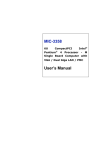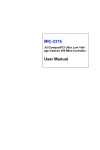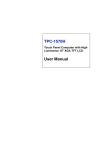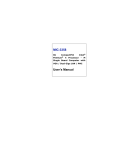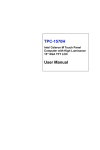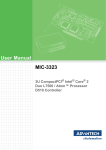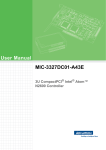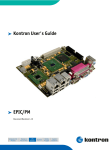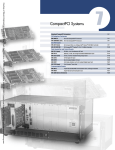Download Advantech MIC-3318 User's Manual
Transcript
MIC-3318 3U-sized CompactPCI® Intel® Pentium® 4-M Single Board Computer with VGA / Dual Giga LAN Modular Industrial Computer Copyright Notice This document is copyrighted, 2004. All rights are reserved. The original manufacturer reserves the right to make improvements to the products described in this manual at any time without notice. No part of this manual may be reproduced, copied, translated or transmitted in any form or by any means without the prior written permission of the original manufacturer. Information provided in this manual is intended to be accurate and reliable. However, the original manufacturer assumes no responsibility for its use, nor for any infringements upon the rights of third parties which may result from its use. Acknowledgements Award is a trademark of Award Software International, Inc. Fast EtherChannel (FEC) is a trademark of Cisco Systems, Inc. IBM, PS/2, OS/2, and VGA are trademarks of International Business Machines Corporation. Intel, Pentium, and PRO/1000+ are trademarks of Intel Corporation. Windows is a registered trademark of Microsoft Corporation. NetWare is a trademark of Novell, Inc. Symbios is a trademark of Symbios Logic Corporation. PICMG™, CompactPCI™ and the PICMG™, and CompactPCI™ logos are trademarks of the PCI Industrial Computers Manufacturers Group. All other product names or trademarks are properties of their respective owners. CE Notification The MIC-3318, developed by Advantech CO., LTD., has passed the CE test for environment specification when shielded cables are used for external wiring and sleeve core clamps are added to the USB cables. We recommend the use of shielded cables and sleeve core clamps. Part No. 2003331800 Printed in Taiwan 1st Edition February 2004 ii Product Warranty Advantech warrants to you, the original purchaser, that each of its products will be free from defects in materials and workmanship for one year from the date of purchase. This warranty does not apply to any products which have been repaired or altered by persons other than repair personnel authorized by Advantech, or which have been subject to misuse, abuse, accident or improper installation. Advantech assumes no liability under the terms of this warranty as a consequence of such events. Because of Advantech’s high quality-control standards and rigorous testing, most of our customers never need to use our repair service. If an Advantech product is defective, it will be repaired or replaced at no charge during the warranty period. For out-of-warranty repairs, you will be billed according to the cost of replacement materials, service time and freight. Please consult your dealer for more details. If you think you have a defective product, follow these steps: 1. Collect all the information about the problem encountered. (For example, CPU speed, Advantech products used, other hardware and software used, etc.) Note anything abnormal and list any onscreen messages you get when the problem occurs. 2. Call your dealer and describe the problem. Please have your manual, product, and any helpful information readily available. 3. If your product is diagnosed as defective, obtain an RMA (return merchandize authorization) number from your dealer. This allows us to process your return more quickly. 4. Carefully pack the defective product, a fully-completed Repair and Replacement Order Card and a photocopy proof of purchase date (such as your sales receipt) in a shippable container. A product returned without proof of the purchase date is not eligible for warranty service. 5. Write the RMA number visibly on the outside of the package and ship it prepaid to your dealer. iii Packing List Before installing your board, ensure that the following materials have been received: • One MIC-3318 all-in-one single board computer • One utility CD-ROM • Two serial port cables • One 6-pin mini-DIN to PS/2 keyboard and PS/2 mouse cable • One hard disk drive (IDE) interface cable (44-pin) • One warranty certificate • This user’s manual If any of these items are missing or damaged, contact your distributor or sales representative immediately. Technical Support and Sales Assistance If you have any technical questions about the MIC-3318 or any other Advantech products, please visit our support website at: • http://www.advantech.com.tw/support For more information about Advantech’s products and sales information, please visit: • http://www.advantech.com iv Contents 1. Hardware Configuration....................1 1.1 Introduction ......................................................... 2 1.2 Specifications....................................................... 3 1.2.1 Standard SBC functions .......................................................... 3 1.2.2 Display ...................................................................................... 4 1.2.3 Mechanical and Environmental Specifications ................... 4 1.3 Function Block Diagram ................................... 5 1.4 Board Dimensions ............................................... 6 1.5 Jumper Settings .................................................. 7 1.5.1 1.5.2 1.5.3 1.5.4 1.5.5 1.5.6 1.6 1.7 1.8 1.9 Assembling / Disassembling MIC-3318 ............................ 7 Jumper Locations ................................................................... 8 Jumper Settings ...................................................................... 9 CompactFlash master/slave selection(1F-JP5, pin 1,2) . 10 Clear CMOS (JP1, pin 2,4,6) .............................................. 10 Serial Ports (COM1 and COM2) Mode ........................... 11 Connectors ......................................................... 12 Front Panel Connectors and Indicators ........ 14 Safety Precautions ............................................ 14 Installing SDRAM (SODIMMs) ..................... 15 2. Connecting Peripherals ....................17 2.1 2.2 2.3 2.4 IDE Device (2F-CN8, CN9)............................. 18 CompactFlash Interface (1F-CN2)................. 18 VGA Display Connector (1F-CN7) ................. 18 PS/2 Keyboard and Mouse Conn. (1F-CN1) . 18 v 2.5 2.6 2.7 2.8 Serial Ports (2F-CN3, CN5, CN4, CN6) ....... 19 Ethernet Configuration (2F-RJ1, RJ2) .......... 19 USB Connector (1F-CN15, CN16) ................. 19 Card Installation ............................................... 20 3. Software Configuration ....................23 3.1 3.2 3.3 3.4 Overview ............................................................ 24 Utilities and Drivers .......................................... 25 USB driver ......................................................... 28 Watchdog Timer (WDT) Driver ..................... 28 3.4.1 Installing the Driver for the MIC-3318 Watchdog .......... 28 3.4.2 How to Use the MIC-3318 Watchdog Timer ................... 32 4. Award BIOS Setup ............................35 4.1 Introduction ....................................................... 36 4.2 Entering Setup ................................................... 37 4.2.1 Standard CMOS Setup ......................................................... 37 4.2.2 Advanced BIOS Features Setup ......................................... 38 4.2.3 Advanced Chipset Features Setup ..................................... 42 4.2.4 Integrated Peripherals ......................................................... 45 4.2.5 Power Management Setup .................................................. 48 4.2.6 PNP/PCI Configuration Setup ............................................. 49 4.2.7 PC Health Status ................................................................... 51 4.2.8 Load Optimized Defaults ..................................................... 51 4.2.9 Set Password .......................................................................... 52 4.2.10 Save & Exit Setup .............................................................. 52 4.2.11 Exit Without Saving ............................................................ 52 vi A. Programming the Watchdog Timer 53 A.1 Overview ........................................................... 54 A.2 Programming the Watchdog Timer ............... 54 A.3 Example Programs .......................................... 56 B. Pin Assignments ................................65 B.1 B.2 B.3 B.4 B.5 B.6 B.7 B.8 PS/2 Keyboard and Mouse Port (1F-CN1) ... 66 CompactFlash Interface (1F-CN2) ................ 67 DB-15 VGA Port (1F-CN7)............................. 68 USB 1.1/2.0 Ports ............................................. 69 COMport ........................................................... 70 Parallel Port (2F-CN7,2F-CN8) ..................... 71 Secondary IDE Connector for 2.5" HDD ..... 72 Gigabit LAN Port (2F-RJ1,2F-RJ2).............. 74 vii Figures Figure 1-1: MIC-3318 function block diagram ........................................................ 5 Figure 1-2: MIC-3318 board dimensions .................................................................. 6 Figure 1-3: How to disassemble/assemble MIC-3318 ............................................. 7 Figure 1-4: MIC-3318 jumper locations (1F) ........................................................... 8 Figure 1-5: MIC-3318 jumper locations (2F) ........................................................... 8 Figure 1-6: MIC-3318 connector locations (1F) ..................................................... 13 Figure 1-7: MIC-3318 connector locations (2F) ..................................................... 13 Figure 1-8: MIC-3318 front panel connector and indicator locations ............... 14 Figure 2-1: Installing/removing the MIC-3318 into/from the chassis ................ 21 Figure 4-1: Initial screen of the setup program .................................................... 36 Figure 4-2: Standard CMOS setup screen. ............................................................ 37 Figure 4-.3: Advanced BIOS features setup screen ............................................... 38 Figure 4-4: Advanced Chipset Features setup screen ........................................... 42 Figure 4-5: Integrated Peripherals setup screens ................................................. 45 Figure 4-6: Power Management Setup screen ...................................................... 48 Figure 4-7: PNP/PCI configuration screen ............................................................ 49 Figure 4-8: PC Health Status setup screen ............................................................ 51 Figure A-1: Procedure of programming the watchdog timer ............................... 54 Tables Table 1-1: MIC-3318 jumper descriptions ................................................................ 8 Table 1-2: CompactFlash master/slave selection .................................................. 10 Table 1-3: Clear CMOS ........................................................................................... 11 Table 1-4: COM 1 Mode (RS-232/422/485 Selection) ........................................... 11 Table 1-5: MIC-3318 connector descriptions ......................................................... 12 Table 2-1: MIC-3318 serial port default settings .................................................. 19 Table A-1: Watchdog timer registers ....................................................................... 55 iix CHAPTER Hardware Configuration 1 1.1 Introduction The MIC-3318 is a 3U-sized CompactPCI all-in-one single board computer with Intel Pentium 4 Processor-M and compliance with the PICMG 2.0 R2.1 CompactPCI specifications. The MIC-3318 features a powerful onboard Intel Pentium 4 Processor–M 1.7 GHz CPU with low power dissipation. This CPU is designed for fanless operation and has a wide operating temperature range. The MIC-3318 offers very powerful functions on a 3U-sized board for performance-demanding applications like real-time machine control and industrial automation. The MIC-3318 has been optimized for the Intel Pentium 4 Processor-M and Intel 845GV Chipset. It unveils a high performance cPCI platform that delivers compelling system bus speed performance across the 400 MHz Intel NetBurst Micro-Architecture. Innovative, wide data paths and flexible memory refresh technology, optimize the DDR SDRAM performance in MIC-3318. High Performance Intel Pentium 4 Processor-M The MIC-3318 supports the Intel Pentium 4 processor-M 1.7 GHz , with the µ-FCPGA package. The Intel Pentium 4 processor-M has on-chip 512KB L2 cache providing high performance. With the support of a 400 MHz front side bus, the MIC-3318 can fulfill customer’s expectations of price-performance and computing capability. Compact Mechanical Design The MIC-3318 has many functions for only 2-slots. Advantech provides a CPU heat sink specially designed for the Intel Pentium 4 processor-M, enabling the MIC-3318 to operate without a cooling fan on the heat sink. It only needs external cooling air from the chassis fans for ventilation. This enables the MIC-3318 to use the powerful Intel Pentium 4 processor-M within a mere 2-slot wide space. 2 MIC-3318 User's Manual 1.2 Specifications 1.2.1 Standard SBC functions • CPU: Intel® Pentium® 4 processor-M µ-FCPGA socket • BIOS: Award 4 Mb flash memory • Chipset: Intel ® 82845GV Graphics and Memory Controller Hub (GMCH) • Intel 82801DB I/O Controller Hub (ICH4) • Front Side Bus: 400 MHz (Intel Pentium 4 processor-M) • 2nd level cache: Built-in 512 KB on Intel Pentium 4 processor-M die • RAM: 200-pin SO-DIMM. Support up to 512 MB non-ECC DDR200/ 266. • Enhanced IDE interface: In DAU Board, One IDE channel has two connector (One IDE connector with space reserved for embedded 2.5” HDD and one external 44-pin (2mm) connector for external IDE Device). Supports PIO mode 4(16.67 MB/s data transfer rate) and Ultra ATA 100/66/33 (100/66/33 MB/s data transfer rate). BIOS enabled/disabled. • CompactFlash socket: one IDE CompactFlash socket onboard. • Enhanced Parallel Port: Configurable to LPT1, LPT2, LPT3, or disabled. Standard DB-25 female connector provided. Supports EPP/ SPP/ECP • Serial ports: Two RS-232/422/485(jumper selectable) ports with 16C550 UARTs (or compatible) with 16-byte FIFO buffer. Supports speeds up to 115.2 Kbps. Ports can be individually configured to COM1, COM2 or disabled • Keyboard and PS/2 mouse connector: One 6-pin mini-DIN connector is located on the mounting bracket for easy connection to a keyboard or PS/2 mouse. An onboard keyboard pin header connector is also available Chapter 1 Hardware Configuration 3 • USB port: Two USB ports with fuse protection comply with USB specification 2.0/1.1 • PCI-to-PCI Bridge: One PERICOM PI7C8150 controller chip, drives up to seven bus master peripherals. • Watchdog Timer: It provides system reset, software control. Time interval is programmable from 1 to 255 seconds/minutes. • Ethernet LAN:10/100/1000Base-TX Ethernet Interface • Controller Chips: Two Intel® 82540EM Gigabit Ethernet controller chips provides Dual Gigabit ports, two front RJ-45 Gigabit LAN port 10 Mbps, 100 Mbps and 1000Mbps auto-switching • PICMG 2.1 CompactPCI Hot Swap Specification R1.0 Compliant 1.2.2 Display •Interface: Intel® Extreme Graphics Architecture • Controller: Intel 845GV chipset integrated •Display memory: shared from system memory up to 8-64MB SDRAM • Bus Interface: PCI 2.2 compliant, 32bit/33 MHz 1.2.3 Mechanical and Environmental Specifications • Board Size: 160 x 100 mm (3U size), 2-slot (8TE) wide. • Max. power Requirements: CPU 1.7 GHz +5 V (4.75 ~ 5.25 V) @ 5.6A +3.3 V (4.75 ~ 5.25 V) @ 1.8A +12 V (4.75 ~ 5.25 V) @ 16mA • Operating Temperature: -10 ~ 50° C (14 ~122° F) CPU Run at 1.7 GHz -10 ~ 60° C (14 ~140° F) CPU Run at 1.2 GHz 4 MIC-3318 User's Manual • Storage Temperature: -40° C ~ 80° C (-40 ~ 176° F) • Humidity (operating and storage): 5 ~ 95% (60° C , non-condensing) • Board weight: 0.8 kg (1.8lb) • Shock: 20 G (operating); 50 G (storage/transit) • Random vibration: 1.5 Grms 1.3 Function Block Diagram Figure 1-1: MIC-3318 function block diagram Chapter 1 Hardware Configuration 5 1.4 Board Dimensions 160 mm 100 mm Figure 1-2: MIC-3318 board dimensions 6 MIC-3318 User's Manual 1.5 Jumper Settings 1.5.1 Assembling / Disassembling MIC-3318 Since MIC-3318 is composed of one main board and one daughter board, for ease of understanding and a convenient naming, we will use 1F (means 1st floor) to represent the main board, and 2F (means 2nd floor) to represent the daughter board hereafter in this manual. Before setting the jumpers, you need to disassemble the MIC-3318 to access the component side of 1F. Figure 1-3 shows how MIC-3318 is disassembled/assembled. CPU Main board (1F) Heat sink Daughter board (2F) HDD bracket HDD CPU Socket I/O Pane l Figure 1-3: How to disassemble/assemble MIC-3318 Chapter 1 Hardware Configuration 7 1.5.2 Jumper Locations The MIC-3318 provides jumpers for configuring your board for specific applications other than the default settings. Table 1-1 lists the jumper functions of MIC-3318. Figure 1-4 and Figure 1-5 show the locations of the jumpers. Table 1-1: MIC-3318 jumper descriptions Number Function 1F-JP5(1,2) 1F-JP6(1,2,3) 2F-JP1(1-18) 2F-JP2(1-18) 2F-JP3(1,2,3) CompactFlash master/slave selection Clear CMOS COM1 Jumper setting (RS-232/422/485) COM2 Jumper setting (RS-232/422/485) LAN1 SEL(Rear I/O OR :Front Panel) Figure 1-4: MIC-3318 jumper locations (1F) Figure 1-5: MIC-3318 jumper locations (2F) 1.5.3 Jumper Settings This section tells how to set the jumpers to configure your card. It gives the card default configuration and your options for each jumper. After you set the jumpers and install the card, you will also need to run the BIOS Setup program (discussed in Chapter 6) to configure the serial port addresses, floppy/hard disk drive types and system operating parameters. Connections, such as hard disk cables, appear in Chapter 2. For the locations of each jumper, see the board layout diagram depicted earlier in this chapter. You configure your card to match the needs of your application by setting jumpers. A jumper is the simplest kind of electric switch. It consists of two metal pins and a small metal cap (often protected by a plastic cover) that slides over the pins to connect them. To "close" a jumper you connect the pins with the cap. To "open" a jumper you remove the cap. Sometimes a jumper will have three pins, labeled 1, 2 and 3. In this case you connect either pins 1 and 2 or 2 and 3. 1 Open Closed 2 3 Closed 2-3 The jmper settings are schematically depicted in this manual as follows: 1 2 Open 1 2 Closed 1 2 3 Closed 2-3 You may find a pair of needle-nose pliers useful for setting the jumpers. If you have any doubts about the best hardware configuration for your application, contact your local distributor or sales representative before you make any changes. 1.5.4 CompactFlash master/slave selection(1F-JP5, pin 1,2) This jumper is used to set the CompactFlash card to be IDE master or slave. The CompactFlash socket is connected to the primary IDE channel. If a CompactFlash card and an IDE drive are connected to the primary IDE channel at the same time, we recommend to set the CompactFlash card as master and the other IDE drive as slave. Otherwise, the MIC-3318 may not be able to detect the CompactFlash correctly. Table 1-2: CompactFlash master/slave selection Mode Master Slave JP5 1 2 1 2 1.5.5 Clear CMOS (JP1, pin 2,4,6) This jumper is used to erase CMOS data and reset system BIOS information. Follow the procedures below to clear the CMOS. 1. Turn off the system. 2. Close jumper JP6 (2-3). 3. Turn on the system. The CMOS is now cleared. 4. Turn off the system. Close jumper JP6 (1-2). 5. Turn on the system. The BIOS is reset to its default setting. 10 MIC-3318 User's Manual Table 1-3: Clear CMOS CMOS JP6 1 2 3 1 2 3 Clear Normal 1.5.6 Serial Ports (COM1 and COM2) Mode (RS-232/ 422/485) This jumper is used to set the Serial ports to act in RS-232,422 or 485 transmission mode. The transmission mode of COM1 and COM2 ports can be selected using the following settings of JP1(Pin 1 to 18) and JP2(Pin 1 to 18) respectively. 1. RS-232 mode: close jumper JP1(5-6, 7-9, 8-10, 13-15, 14-16) for COM1, JP2(5-6, 7-9, 8-10, 13-15, 14-16) for COM2. 2. RS-422 mode: close jumper JP1(3-4, 9-11, 10-12, 15-17, 16-18) for COM1, JP2(3-4, 9-11, 10-12, 15-17, 16-18) for COM2. 3. RS-485 mode: close jumper JP1(1-2, 9-11, 10-12, 15-17, 16-18) for COM1, JP2(1-2, 9-11, 10-12, 15-17, 16-18) for COM2. Table 1-4: COM 1 Mode (RS-232/422/485 Selection) CMOS 2F JP1 and JP2 2 4 6 8 10 12 14 16 18 RS-232 1 3 5 7 9 11 13 15 17 2 4 6 8 10 12 14 16 18 1 3 5 7 9 11 13 15 17 2 4 6 8 10 12 14 16 18 1 3 5 7 9 11 13 15 17 RS-422 RS-485 Chapter 1 Hardware Configuration 11 1.6 Connectors Onboard connectors link to external devices such as hard disk drives, or keyboards, etc. Table 1-5 lists the function of each connector, and Figure 1-6 and Figure 1-7 illustrate the location of each connector. Table 1-5: MIC-3318 connector descriptions Number Function 1F-CN1 PS/2 keyboard and mouse connector 1F-CN2 Primary IDE CompactFlash Socket 1F-CN7 DB-15 VGA connector 1F-CN15 USB1 1.1/2.0 connector 1F-CN16 USB2 1.1/2.0 connector 1F-J1/J2 Primary CompactPCI bus (32-bit, 33MHz) 1F-SW1 RESET Switch 1F-D9 POWER LED 1F-D10 HDD LED 1F-DIMM1 SODIMM 200-pin socket for DDR 2F-CN3 Serial port: COM2 2F-CN4 Serial port: COM2 External Connector to 3F 2F-CN5 Serial port: COM1 2F-CN6 Serial port: COM1 External Connector to 3F 2F-CN7 Parallel port 2F-CN8 Parallel port External Connector to 3F 2F-CN9 Secondary IDE connector for 2.5" HDD 2F-CN17 Secondary IDE connector 2F-RJ1 10/100/1000Base-T Ethernet connector 1 2F-RJ2 10/100/1000Base-T Ethernet connector 2 Please refer to Appendix B for pin assignments. 12 MIC-3318 User's Manual CN14 CN13 J2 CN7(VGA) CN2(CF) CN15(USB1) CN16(USB2) DIMM1 J1 CN1(PS/2) RESET POWER LED CPU1 Figure 1-6: MIC-3318 connector locations (1F) Fig.1-6 CN5 (COM1) CN8 (PRT) CN7 (PRT) CN3 (COM2) CN6 (COM1) CN4 (COM2) CN9 (IDE) CN17 (IDE) RJ1 (LAN1) CN8 (Parallel) RJ2 (LAN2) FigureFig.1-7 1-7: MIC-3318 connector locations (2F) Chapter 1 Hardware Configuration 13 1.7 Front Panel Connectors and Indicators Figure 1-8: MIC-3318 front panel connector and indicator locations 1.8 Safety Precautions Follow these simple precautions to protect yourself from harm and the products from damage. 1. To avoid electrical shock, always disconnect the power from your PC chassis before you work on it. Don't touch any components on the CPU card or other cards while the PC is on. 2. Disconnect power before making any configuration changes. The sudden rush of power as you connect a jumper or install a card may damage sensitive electronic components. 14 MIC-3318 User's Manual 3. Always ground yourself to remove any static charge before you touch your CPU card. Be particularly careful not to touch the chip connectors. Modern integrated electronic devices, especially CPUs and memory chips, are extremely sensitive to static electrical discharges and fields. Keep the card in its antistatic packaging when it is not installed in the PC, and place it on a static dissipative mat when you are working with it. Wear a grounding wrist strap for continuous protection. 1.9 Installing SDRAM (SODIMMs) The MIC-3318 provides one 200-pin SODIMM socket, which is on the component side of 1F. The socket accepts 128, 256 or 512 MB DDR. The socket can be filled with DIMMs of any size, giving a total memory capacity between 128 and 512 MB. The procedure for installing SODIMMs appears below. Please follow these steps carefully. 1. Ensure that all power supplies to the system are switched Off. 2. Install the SODIMM module. Install the SODIMM so that its gold pins point down into the SODIMM socket. 3. Slip the SODIMM into the socket at a 45 degree angle and carefully fit the bottom of the module against the connectors. 4. Gently push the SODIMM toward the board until the SODIMM is parallel to the CPU card, and the clips on the ends of the SODIMM sockets snap into place. 5. Check to ensure that the SODIMM is correctly seated and all connector contacts touch. The SODIMM should not move around in its socket. NOTE: The SODIMM modules can only fit into sockets one way, in accordance with the keyed notches along the bottom edge of the modules. Their gold pins must point down into the SODIMM socket. Chapter 1 Hardware Configuration 15 16 MIC-3318 User's Manual CHAPTER Connecting Peripherals 2 2.1 IDE Device (2F-CN8, CN9) The MIC-3318 provides one IDE (Integrated Device Electronics) channel, but supports two secondary IDE devices via two connectors sepeartely, one is for one on-board 2.5" HDD and the other is for wiring out to the front panel to connect with external devices. If two drives are installed on one channel, remember to set one as the master and the other one as the slave. You may do this by setting the jumpers on the drives. Refer to the documentation that came with your drive for more information. A jumper diagram usually appears on the topside of a hard disk drive. Warning: Plug the other end of the cable into the drive with pin #1 on the cable corresponding to pin #1 on the drive. Improper connection will damage the drive. 2.2 CompactFlash Interface (1F-CN2) This socket accepts an IDE-compatible CompactFlash memory card. 2.3 VGA Display Connector (1F-CN7) The MIC-3318 provides an VGA controller for a high performance VGA interface. The MIC-3318's CN7 on 1F is a DB-15 connector for VGA monitor input. Pin assignments for the VGA display are detailed in Appendix B. 2.4 PS/2 Keyboard and Mouse Conn. (1F-CN1) The MIC-3318 provides a 6-pin mini-DIN connector on the front panel for connection of PS/2 keyboard and PS/2 mouse. The MIC-3318 comes with an cable to convert from the single 6-pin mini-DIN connector to a double PS/2 keyboard connector and PS/2 mouse connector. Since these two connectors are identical, please follow the icons on the cable to plug the keyboard and the mouse into their correct connectors. 18 MIC-3318 User's Manual 2.5 Serial Ports (2F-CN3, CN5, CN4, CN6) The MIC-3318 offers two serial ports: both support RS-232/422/485 modes (jumper selectable) via two DB-9 connectors seperately. These ports allow users to connect to serial devices or a communication network. You can select the address for each port to disable it, using the BIOS Advanced Setup program, covered in Chapter 4. Different devices implement the RS-232/422/485 standard in different ways. If you are having problems with a serial device, be sure to check the pin assignments for the connector. The IRQ and address range for both ports are fixed. However, if you wish to disable the port or change these parameters later, you can do this in the system BIOS setup. The table below shows the settings for the MIC-3318 board's ports: Table 2-1: MIC-3318 serial port default settings Port Address Interrupt Default COM1 3F8, 2F8, 3E8, 2E8 IRQ4/IRQ3 3F8/IRQ4 COM2 3F8, 2F8, 3E8, 2E8 IRQ4/IRQ3 2F8/IRQ3 2.6 Ethernet Configuration (2F-RJ1, RJ2) The MIC-3318 is equipped with a high performance 32-bit PCI-bus Gigabit Ethernet interface which is fully compliant with IEEE 802.3u 10/ 100/1000Base-TX specifications. 2.7 USB Connector (1F-CN15, CN16) The MIC-3318 provides two USB (Universal Serial Bus) 2.0 channels via two ports on the front panel, which give complete plug and play, hot attach/detach ability for up to 127 external devices. The USB interfaces comply with USB specification rev. 2.0 and are polyswitch protected. The USB interfaces can be disabled in the system BIOS setup. Chapter 2 Connecting Peripherals 19 2.8 Card Installation The CompactPCI connectors are firm and rigid, and require careful handling while plugging and unplugging. Improper installation of a card can easily damage the backplane of the chassis. The inject/eject handle of MIC-3318 helps you install and remove the card easily and safely. Follow the procedure below to install the MIC3318 into a chassis: To install a card: 1. Hold the card vertically. Be sure that the card is pointing in the correct direction. The components of the card should be pointing to the right-hand side. 2. Holding the lower handle, pull out the red portion in the middle of the handle to unlock it. Caution: Keep your fingers away from the hinge to prevent them from getting pinched. 3. Insert the card into the chassis by sliding the upper and lower edges of the card into the card guide. 4. Push the card into the slot gently by sliding the card along the card guide until the handles meet the rectangular holes of the cross rails. Note: If the card is correctly positioned and has been slid all the way into the chassis, the handle should match the rectangular holes. If not, remove the card from the card guide and repeat step 3 again. Do not try to install a card by forcing it into the chassis. 5. Lift the lower handle up to push the card into place. To remove a card: 1. Unscrew the four screws on the front panel. 2. Press the lower handle down to release the card from the backplane. 3. Slide the card out. 20 MIC-3318 User's Manual Figure 2-1: Installing/removing the MIC-3318 into/from the chassis Chapter 2 Connecting Peripherals 21 22 MIC-3318 User's Manual CHAPTER Software Configuration 3 3.1 Overview Advantech provides a CD-ROM with utilities and drivers included. Please install the Chipset INF driver, VGA graphics driver, LAN driver, Intel Application Accelerator (IAA) driver, Watchdog Timer (WDT) driver and the hardware monitoring utility (WinBond HWDoct) sequentially. The Intel Application Accelerator is a performance boosting software package for Intel chipsets. It reduces the storage sub-system bottleneck, enabling faster delivery of data from the hard drive to the processor and other system level hardware. Meanwhile, it enables a performance-enhancing data pre-fetcher for Intel Pentium 4 and Pentium M processor-based systems. In addition, it delivers faster overall system boot times by significantly accelerating the load time of the OS, which enables you to build Pentium 4 and Pentium M processor-based systems with a better overall end-user experience. IAA supports 48-bit Logical Block Addressing (48-bit LBA) for 137 GB and larger hard drives. Furthermore, IAA enables Automatic Selection of Highest DMA Transfer Mode by the ATA/ATAPI device/ Intel chipset. This chapter will list the utilities and drivers for MIC-3318, and make a brief introduction for two of them: the USB driver and the Watchdog Timer utility. 24 MIC-3318 User's Manual 3.2 Utilities and Drivers The following utilities and drivers are provided with MIC-3318. You can also find out the updated description of the utilities and drivers in the ReadMe.txt file on the CD-ROM. Intel Chipset Software Installation Utility Path: \Driver\Chipset\845G\ Available for the OS’s below, • Microsoft Windows 98 SE • Microsoft Windows ME • Microsoft Windows 2000 • Microsoft Windows XP • Microsoft Windows Server 2003 VGA Drivers (Intel Extreme Graphics 2 Driver) Path: \Driver\VGA\845GV\ Available for the OS’s below, • Microsoft Windows 98 SE • Microsoft Windows ME • Microsoft Windows NT 4.0 • Microsoft Windows 2000 • Microsoft Windows XP Chapter 3 Software Configuration 25 IDE Drivers (Intel Application Accelerator) Path: \Driver\Ide\ICH4\ Available for the OS’s below, • Microsoft Windows 98 SE • Microsoft Windows ME • Microsoft Windows NT 4.0 • Microsoft Windows 2000 • Microsoft Windows XP Intel Gigabit LAN 82540EM Drivers /Utility Path: \Driver\Lan\82540EM\ Available for the OS’s below, • Microsoft Windows 98 SE • Microsoft Windows ME • Microsoft Windows NT 4.0 • Microsoft Windows 2000 • Microsoft Windows XP • Win dows NT Embedded 4.0 • Windows XP Embedded • Linux • NetWare_ Novell ODI and more, on the driver CD-ROM. 26 MIC-3318 User's Manual USB Drivers /Utility Path: \Driver\Usb\ICH4\ Available for the OS’s below, • Microsoft Windows 98 SE • Microsoft Windows ME • Microsoft Windows 2000 • Microsoft Windows XP Hardware Monitor Utility Path: \Driver \OBS\MIC3318\ Available for the OS’s below, • Microsoft Windows 2000 • Microsoft Windows XP WatchDog Timer Driver Path: \Driver\WDT\W8362x\ Available for the OS’s below, • Microsoft Windows 2000 • Microsoft Windows XP Chapter 3 Software Configuration 27 3.3 USB driver If the manufacturer/vendor of a USB device recommends downloading an Intel USB driver update as part of troubleshooting your USB device, please contact Microsoft for USB driver support. Intel manufactures the host controller but the driver is from Microsoft. While you install the Intel INF driver, it will not install the USB driver. Please go to "device manager" to update the USB driver via the Advantech CD utility or via Microsoft’s website. Note: There are no separate USB (version 1.1 and earlier) drivers available to download for Intel chipsets. 3.4 Watchdog Timer (WDT) Driver In order to ensure reliable and fail-safe performance, MIC-3318 has a built-in Watchdog Timer to take care of unexpected system failures. Advantech provides the drivers and a utility to activate and configure the timer for Windows2000/XP operating systems. The following is a brief introduction, using Windows2000 as an example, for the installation and configuration procedures. 3.4.1 Installing the Driver for the MIC-3318 Watchdog Timer Step 1. Insert the companion CD-ROM into your CD-ROM drive. Open the directory:\Driver\WDT\8362x\W2K_XP. 28 MIC-3318 User's Manual Step 2. Use Windows Explorer (or Windows Run command) to execute SETUP.EXE from the companion CD-ROM. Step 3. Click Next to proceed. Step 4. Click Next to confirm the customer information. Chapter 3 Software Configuration 29 Step 5. Select Advantech [W83627HF] Watchdog Timer and click Next to proceed. Step 6. Click Next to confirm selecting the Typical setup type. Step 7. Click Next to proceed. 30 MIC-3318 User's Manual Step 8. Click Finish to complete the procedure. Step 9. Click OK to restart the system and activate the Watchdog Timer. Chapter 3 Software Configuration 31 3.4.2 How to Use the MIC-3318 Watchdog Timer Step 1. Open the Control Panel of the Windows and click Watchdog Service Configuration. Step 2. Click the Start Service button. Step 3. Click Setting to select the setting page. Step 4. Select the Timer Span that meets your application requirement. 32 MIC-3318 User's Manual Step 5. Click Enable to enable the setting. Step 6. Check the Start watchdog service on boot to enable the Watchdog timer to start automatically after the system boots every time. Step 7. Click OK, then the configuration procedure is finished. Chapter 3 Software Configuration 33 34 MIC-3318 User's Manual CHAPTER 4 Award BIOS Setup 4.1 Introduction Once you enter the Award BIOS CMOS Setup Utility, the Main Menu (Figure 4-1) will appear on the screen. The Main Menu allows you to select between nine setup functions and two exit choices. Use the arrow keys to select among the items and press <Enter> to accept or enter the submenu. Figure 4-1: Initial screen of the setup program Award's BIOS ROM has a built-in Setup program that allows users to modify the basic system configuration. This type of information is stored in battery-backed CMOS so that it retains the Setup information when the power is turned off. 36 MIC-3318 User's Manual 4.2 Entering Setup Turn on the computer and check for the "patch code". If there is a number assigned to the patch code, it means that the BIOS supports your CPU. If there is no number assigned to the patch code, please contact Advantech's application engineer to obtain an up-to-date patch code file. This will ensure that your CPU's system status is valid. After ensuring that you have a number assigned to the patch code, press <DEL> and you will immediately be allowed to enter setup. 4.2.1 Standard CMOS Setup The items in the Standard CMOS Setup Menu are divided into 11 categories. Each category includes none, one, or more than one setup items. Use the arrow keys to highlight the item and then use the <PgUp> or <PgDn> keys to select the value you want in each item. Figure 4-2: Standard CMOS setup screen. Chapter 4 Award BIOS Setup 37 Primary Master/Primary Slave/Secondary Master/Secondary Slave Press PgUp/<+> or PgDn/<-> to select Manual, None, Auto type. Note that the specifications of your drive must match with the drive table. The hard disk will not work properly if you enter improper information for this category. If your hard disk drive type is not matched or listed, you can use Manual to define your own drive type manually. If you select Manual, related information is entered to the following items. Enter the information directly from the keyboard. This information should be provided in the documentation from your hard disk vendor or the system manufacturer. 4.2.2 Advanced BIOS Features Setup The "Advanced BIOS Features" screen will appear after the BIOS FEATURES SETUP item from the CMOS SETUP UTILITY menu was chosen. This screen allows the user to configure the board according to his particular requirements. Below are some major items that are provided in the BIOS FEATURES SETUP screen: Figure 4-.3: Advanced BIOS features setup screen 38 MIC-3318 User's Manual Virus Warning During and after the system boots up, any attempt to write to the boot sector or partition table of the hard disk drive will halt the system. If this happens, a warning message will be displayed. You can run the anti-virus program to locate the problem. If the Virus Warning is disabled, no warning message will appear if anything attempts to access the boot sector or hard disk partition. CPU L1 & L2 Cache Enabled (default) Enable cache Disabled Disable cache Note: The internal cache is built into the processor. Quick Power On Self Test This category speeds up Power On Self Test (POST) after you power on the computer. If this is set to Enabled, BIOS will shorten or skip some check items during POST. Enabled (default) Enable quick POST Disabled Normal POST Chapter 4 Award BIOS Setup 39 First/Second/Third Boot Device and Boot Other Device The BIOS attempts to load the operating system from the devices in the sequence selected in these items. The settings are Floppy, LS120, HDD-0, SCSI, CDROM, HDD-1, HDD-2, HDD-3, ZIP100, USB-FDD, USB-ZIP, USB-CDROM, USB-HDD, LAN and Disabled. Order Default First boot device USB-FDD Second boot device HDD-0 Third boot device HDD-1 PS: When you boot by USB CD-ROM, please install Win XP with SP1 or Win 2000 with SP3. Boot Up NumLock Status The default value is On. On (default) Keypad is numeric keys. Off Keypad is arrow keys. Gate A20 Options Normal The A20 signal is controlled by keyboard controller or chipset hardware. Fast (default) chipset The A20 signal is controlled by port 92 or specific method. Typematic Rate Setting Key strokes repeat at a rate determined by the keyboard controller. When enabled, the typematic rate and typematic delay can be selected. The settings are: Enabled/Disabled. The default is Disabled. 40 MIC-3318 User's Manual Typematic Rate (Chars/Sec) Set the number of times a second to repeat a keystroke when you hold the key down. The settings are: 6, 8, 10, 12, 15, 20, 24, 30. Typematic Delay (Msec) Sets the delay time after the key is held down before it begins to repeat the keystroke. The settings are: 250, 500, 750, 1000. Security Options This category allows you to limit access to the system and Setup, or just to Setup. System The system will not boot and access to Setup will be denied if the correct password is not entered at the prompt. Setup(default) The system will boot, but access to Setup will be denied if the correct password is not entered at the prompt. APIC Mode (Advanced Programmable Interrupt Controller) Default is Enabled. MPS Version Control for OS The options include 1.1 and 1.4. Default is 1.4 OS Select For DRAM > 64MB Allows OS2 to be used with > 64 MB of DRAM. Settings are Non-OS/2 (default) and OS2. Set to OS/2 if using more than 64MB and running OS/2. Chapter 4 Award BIOS Setup 41 Small logo (EPA) show Default is Disabled. Max Performance It is Pentium 4 M processor setting operation in 1.7 GHz or 1.2 GHz Enabled (default) CPU operation in 1.7 GHz Disabled CPU operation in 1.2 GHz 4.2.3 Advanced Chipset Features Setup The Advanced Chipset Features Setup option is used to change the values of the chipset registers. These registers control most of the system options in the computer. Choose the "Advanced Chipset Features" from the main menu and the following screen will appear. Figure 4-4: Advanced Chipset Features setup screen 42 MIC-3318 User's Manual DRAM Timing Configuration This field lets you select system memory timing data. Manual and BY SPD are two options. Default is "BY SPD" CAS Latency Time When synchronous DRAM is installed, the number of clock cycles of CAS latency depends on the DRAM timing. The settings are: 1.5, 2 and 2.5. Active to Precharge Delay This field let you select the active to precharge delay. The settings are: 7, 6 and 5 DRAM RAS# to CAS# Delay This field is used to insert a timing delay between the CAS and RAS strobe signals, used when DRAM is written to, read from, or refreshed. Fast gives faster performance; and Slow gives more stable performance. This field applies only when synchronous DRAM have been installed in the system. The settings are: 2 and 3. DRAM RAS# Precharge If an insufficient number of cycles is allowed for the RAS to accumulate its charge before DRAM refresh, the refresh may be incomplete and the DRAM may fail to retain data. Fast gives faster performance; and Slow gives more stable performance. This field applies only when synchronous DRAM is installed in the system. The settings are: 2 and 3. Memory Frequency For User can select 3 options: DDR200, DDR266, Auto (Default) Chapter 4 Award BIOS Setup 43 System BIOS Cacheable Selecting Enabled allows caching of the system BIOS ROM at F0000hFFFFFh, resulting in better system performance. However, if any program writes to this memory area, a system error may result. The settings are: Enabled (Default) and Disabled. Video BIOS Cacheable Select Enabled allows caching of the video BIOS, resulting in better system performance. However, if any program writes to this memory area, a system error may result. The settings are: Enabled and Disabled (Default). Memory Hole At 15M-16M You can reserve this area of system memory for ISA adapter ROM. When this area is reserved, it cannot be cached. The user information of peripherals that need to use this area of system memory usually discusses their memory requirements. The settings are: Enabled and Disabled (Default). Delayed Transaction The chipset has an embedded 32-bit posted write buffer to support delay transactions cycles. Select Enabled to support compliance with PCI specification version 2.1. The settings are: Enabled (Default) and Disabled. AGP Aperture Size (MB) Select the size of Accelerated Graphics Port (AGP) aperture. The aperture is a portion of the PCI memory address range dedicated for graphics memory address space. Host cycles that hit the aperture range are forwarded to the AGP without any translation. 44 MIC-3318 User's Manual On-Chip Frame Buffer Size User can select the frame buffer size. Options are 8 MB and 1 MB. 4.2.4 Integrated Peripherals Figure 4-5: Integrated Peripherals setup screens Chapter 4 Award BIOS Setup 45 On-Chip Primary/Secondary PCI IDE The integrated peripheral controller contains an IDE interface with support for two IDE channels. Select Enabled to activate each channel separately. The settings are: Enabled (Default) and Disabled. IDE Primary/Secondary Master/Slave PIO The four IDE PIO (Programmed Input/Output) fields let you set a PIO mode (0-4) for each of the four IDE devices that the onboard IDE interface supports. Modes 0 through 4 provide successively increased performance. In Auto mode, the system automatically determines the best mode for each device. The settings are: Auto (Default), Mode 0, Mode 1, Mode 2, Mode 3, Mode 4. IDE Primary/Secondary Master/Slave UDMA Ultra DMA/33 implementation is possible only if your IDE hard drive supports it and the operating environment includes a DMA driver (Windows 95 OSR2 or a third-party IDE bus master driver). If your hard drive and your system software both support Ultra DMA/33 and Ultra DMA/66 and Ultra DMA/100, select Auto to enable BIOS support. The settings are: Auto (Default), Disabled. USB Controller Select Enabled if your system contains a Universal Serial Bus (USB) 1.1 controller. The settings are: Enabled (Default), Disabled. USB 2.0 Controller Select Enabled if your system contains a Universal Serial Bus (USB) 1.1/2.0 controller. The settings are: Enabled (Default), Disabled. USB Keyboard/Mouse Support Select Enabled if you use USB KB/Mouse in DOS mode. Disabled (Default) 46 MIC-3318 User's Manual Init Display First User can choose display priority on either peripheral PCI slot or on board VGA chip. There are 2 options: PCI slot (Default) and On board. IDE HDD Block Mode Block mode is also called block transfer, multiple commands, or multiple sector read/write. If your IDE hard drive supports block mode (most new drives do), select Enabled for automatic detection of the optimal number of block read/writes per sector the drive can support. The settings are: Enabled (Default), Disabled. Onboard FDC Controller Select Enabled if your system has a floppy disk controller (FDD) installed on the system board and you wish to use it. If you install add-on FDC or the system has no floppy drive, select Disabled in this field. The settings are: Enabled (Default) and Disabled. Onboard Serial Port 1/Port 2 Select an address and corresponding interrupt for the first and second serial ports. The Serial Port 1 settings are: 3F8/IRQ4 (Default), 2E8/ IRQ3, 3E8/IRQ4, 2F8/ IRQ3, Disabled, Auto.The Serial Port 2 settings are: 3F8/IRQ4, 2E8/IRQ3, 3E8/IRQ4, 2F8/IRQ3 (Default), Disabled, Auto. Onboard Parallel Port There is a built-in parallel port on the onboard Super I/O chipset that provides Standard, ECP, and EPP features. It has the following options: Disabled, 3BCH/IRQ7 (Default), 278H/IRQ5 , 378H/IRQ7 and Disable Chapter 4 Award BIOS Setup 47 Parallel Port Mode SPP (Default) Standard Parallel Port EPP1.9+SPP Supports both the SPP and EPP1.9 modes ECP Extended Capability Port EPP1.9+ECP Supports both the ECP and EPP1.9 modes Printer Supports Printer modes EPP1.7+SPP Supports both the SPP and EPP1.7 modes EPP1.7+ECP Supports both the ECP and EPP1.7 modes ECP Mode Use DMA The options: 1 and 3 (Default) 4.2.5 Power Management Setup The Power Management Setup allows you to configure you system to most effectively save energy while operating in a manner consistent with your own style of computer use. Figure 4-6: Power Management Setup screen 48 MIC-3318 User's Manual ACPI Function This category allows you to select if ACPI power management are enabled or not. The options: Enabled (Default) and Disabled. 4.2.6 PNP/PCI Configuration Setup This section describes configuring the PCI bus system. PCI, or Personal Computer Interconnect, is a system that allows I/O devices to operate at speeds nearing the speed the CPU itself uses when communicating with its own special components. This section covers some very technical items and it is strongly recommended that only experienced make any changes to the default settings. Figure 4-7: PNP/PCI configuration screen Chapter 4 Award BIOS Setup 49 Reset Configuration Data Normally, you leave this field Disabled. Select Enabled to reset Extended System Configuration Data (ESCD) when you exit Setup if you have installed a new add-on and the system reconfiguration has caused such a serious conflict that the operating system cannot boot. The settings are: Enabled and Disabled (Default). Resource Controlled By The Award Plug and Play BIOS has the capacity to automatically configure all of the boot and Plug and Play compatible devices. However, this capability means absolutely nothing unless you are using a Plug and Play operating system such as Windows® 95/98. If you set this field to "manual" choose specific resources by going into each of the sub menus that follow this field (a sub menu is preceded by a "y"). The settings are: Auto (ESCD) (Default), Manual. IRQ Resources When resources are controlled manually, assign each system interrupt a type, depending on the type of device using the interrupt. PCI/VGA Palette Snoop Leave this field at Disabled. The settings are Enabled, Disabled (Default). 50 MIC-3318 User's Manual 4.2.7 PC Health Status This section shows the Status of you CPU, Fan, Warning for overall system status. This is only available if there is Hardware Monitor onboard. Figure 4-8: PC Health Status setup screen Current CPU Temp./ Vcpu-core/Vtt/+3.3V/+5V (V) This shows system health status. 4.2.8 Load Optimized Defaults When you press <Enter> on this item, you get a confirmation dialog box with a message similar to: Load Optimized Defaults (Y/N) ? N Pressing 'Y' loads the default values that are factory settings for optimal performance system operations. Chapter 4 Award BIOS Setup 51 4.2.9 Set Password To change, confirm, or disable the password, choose the "PASSWORD SETTING" option form the Setup main menu and press [Enter]. The password can be at most 8 characters long. Remember, to enable this feature. You must first select the Security Option in the Advanced BIOS Features Setup to be either "Setup" or "System." Pressing [Enter] again without typing any characters can disable the password setting function. 4.2.10 Save & Exit Setup If you select this and press the [Enter] key, the values entered in the setup utilities will be recorded in the CMOS memory of the chipset. The microprocessor will check this every time you turn your system on and compare this to what it finds as it checks the system. This record is required for the system to operate. 4.2.11 Exit Without Saving Selecting this option and pressing the [Enter] key lets you exit the Setup program without recording any new values or changing old ones. 52 MIC-3318 User's Manual APPENDIX A Programming the Watchdog Timer A.1 Overview The MIC-3318's watchdog timer can be used to monitor system software operation and take corrective action if the software fails to function after the programmed period. This section describes the operation of the watchdog timer and how to program it. The watchdog timer is built-in the super I/O controller W83627HF. It provides the following functions for user programming: • Can be enabled and disabled by user's program. • Timer can be set from 1 to 255 seconds or 1 to 255 minutes. • Generates an interrupt or resets signal if the software fails to reset the timer after time-out. A.2 Programming the Watchdog Timer The I/O port address of the watchdog timer is 2E(hex) and 2F(hex), 2E (hex) is the address port. 2F(hex) is the data port. You must first assign the address of register by writing address value into address port 2E(hex), then write/read data to/from the assigned register through data port 2F (hex). Figure A-1: Procedure of programming the watchdog timer 54 MIC-3318 User's Manual Table A-1: Watchdog timer registers Address of register (2E) Attribute Description Read/Write Value (2F) and description 87 (hex) ----- Write this address to I/O address port 2E (hex) twice to unlock the W83627HF 07 (hex) write Write 08 (hex) to select register of watchdog timer. 30 (hex) write Write 01 (hex) to enable the function of the watchdog timer. Disabled is set as default. F5 (hex) write F6 (hex) write 0: stop timer [default]01~FF (hex): The amount of the count, in seconds or minutes, depends on the value set in register F5 (hex). This number decides how long the watchdog timer waits for strobe before generating an interrupt or reset signal. Writing a new value to this register can reset the timer to count with the new value. F7 (hex) rd/wr Bit 6: Write 1 to enable keyboard to reset the timer, 0 to disable.[default] Bit 5: Write 1 to generate a timeout signal immediately and automatically return to 0. [default=0] Bit 4: Read status of watchdog timer, 1 means timer is "time out". AA (hex) ----- Write this address to I/O port 2E (hex) to lock the watchdog timer.2 Set seconds or minutes as units for the timer. Write 0 to bit 3: set second as counting unit. [default] Write 1 to bit 3: set minute as counting unit Appendix A Programming the Watchdog Timer 55 A.3 Example Programs 1. Enable watchdog timer and set 10 sec. as timeout interval ;----------------------------------------------------------Mov dx,2eh ; Unlock W83627HF Mov al,87h Out dx,al Out dx,al ;----------------------------------------------------------Mov al,07h ; Select registers of watchdog timer Out dx,al Inc dx Mov al,08h Out dx,al ;----------------------------------------------------------Dec dx ; Enable the function of watchdog timer Mov al,30h Out dx,al Inc dx Mov al,01h Out dx,al ;----------------------------------------------------------- 56 MIC-3318 User's Manual Dec dx ; Set second as counting unit Mov al,0f5h Out dx,al Inc dx In al,dx And al,not 08h Out dx,al ;----------------------------------------------------------Dec dx ; Set timeout interval as 10 seconds and start counting Mov al,0f6h Out dx,al Inc dx Mov al,10 Out dx,al ;----------------------------------------------------------Dec dx ; lock W83627HF Mov al,0aah Out dx,al Appendix A Programming the Watchdog Timer 57 2. Enable watchdog timer and set 5 minutes as timeout interval ;----------------------------------------------------------Mov dx,2eh ; unlock W83627H Mov al,87h Out dx,al Out dx,al ;----------------------------------------------------------Mov al,07h ; Select registers of watchdog timer Out dx,al Inc dx Mov al,08h Out dx,al ;----------------------------------------------------------Dec dx ; Enable the function of watchdog timer Mov al,30h Out dx,al Inc dx Mov al,01h Out dx,al ;----------------------------------------------------------- 58 MIC-3318 User's Manual Dec dx ; Set minute as counting unit Mov al,0f5h Out dx,al Inc dx In al,dx Or al,08h Out dx,al ;----------------------------------------------------------Dec dx ; Set timeout interval as 5 minutes and start counting Mov al,0f6h Out dx,al Inc dx Mov al,5 Out dx,al ;----------------------------------------------------------Dec dx ; lock W83627HF Mov al,0aah Out dx,al Appendix A Programming the Watchdog Timer 59 3. Enable watchdog timer to be reset by mouse ;----------------------------------------------------------Mov dx,2eh ; unlock W83627H Mov al,87h Out dx,al Out dx,al ;----------------------------------------------------------Mov al,07h ; Select registers of watchdog timer Out dx,al Inc dx Mov al,08h Out dx,al ;----------------------------------------------------------Dec dx ; Enable the function of watchdog timer Mov al,30h Out dx,al Inc dx Mov al,01h Out dx,al ;----------------------------------------------------------- 60 MIC-3318 User's Manual Dec dx ; Enable watchdog timer to be reset by mouse Mov al,0f7h Out dx,al Inc dx In al,dx Or al,80h Out dx,al ;----------------------------------------------------------Dec dx ; lock W83627HF Mov al,0aah Out dx,al Appendix A Programming the Watchdog Timer 61 4. Enable watchdog timer to be reset by keyboard ;----------------------------------------------------------Mov dx,2eh ; unlock W83627H Mov al,87h Out dx,al Out dx,al ;----------------------------------------------------------Mov al,07h ; Select registers of watchdog timer Out dx,al Inc dx Mov al,08h Out dx,al ;----------------------------------------------------------Dec dx ; Enable the function of watchdog timer Mov al,30h Out dx,al Inc dx Mov al,01h Out dx,al ;----------------------------------------------------------Dec dx ; Enable watchdog timer to be strobed reset by keyboard Mov al,0f7h Out dx,al Inc dx In al,dx Or al,40h Out dx,al 62 MIC-3318 User's Manual ;----------------------------------------------------------Dec dx ; lock W83627HF Mov al,0aah Out dx,al 5. Generate a time-out signal without timer counting ;----------------------------------------------------------Mov dx,2eh ; unlock W83627H Mov al,87h Out dx,al Out dx,al ;----------------------------------------------------------Mov al,07h ; Select registers of watchdog timer Out dx,al Inc dx Mov al,08h Out dx,al ;----------------------------------------------------------Dec dx ; Enable the function of watchdog timer Mov al,30h Out dx,al Inc dx Mov al,01h Out dx,al ;----------------------------------------------------------- Appendix A Programming the Watchdog Timer 63 Dec dx ; Generate a time-out signal Mov al,0f7h Out dx,al ;Write 1 to bit 5 of F7 register Inc dx In al,dx Or al,20h Out dx,al ;----------------------------------------------------------Dec dx ; lock W83627HF Mov al,0aah Out dx,al 64 MIC-3318 User's Manual APPENDIX B Pin Assignments B.1 PS/2 Keyboard and Mouse Port (1F-CN1) 6 5 4 3 2 1 Table B-1: PS/2 keyboard and mouse port pin definitions Pin Signal 1 KB DATA 2 MS DATA 3 GND 4 VCC 5 KB CLOCK 6 MC CLOCK 66 MIC-3318 User's Manual B.2 CompactFlash Interface (1F-CN2) Table B-2: CompactFlash interface pin definitions Pin Signal Pin Signal 1 GND 26 N/C 2 PDD3 27 PDD11 3 PDD4 28 PDD 12 4 PDD5 29 PDD 13 5 PDD6 30 PDD 14 6 PDD7 31 PDD 15 7 PDCS#1 32 PDCS#3 8 GND 33 N/C 9 GND 34 PDIOR# 10 GND 35 PDIOW# 11 GND 36 CF-36 12 GND 37 IRQ14 13 +5V 38 +5V 14 GND 39 SANMODE 15 GND 40 N/C 16 GND 41 IDERST#1 17 GND 42 PDIORDY 18 PDA2 43 N/C 19 PDA1 44 CF-44 20 PDA0 45 CFLED 21 PDD0 46 P66DET 22 PDD1 47 PDD8 23 PDD2 48 PDD9 24 N/C 49 PDD10 25 N/C 50 GND Appendix B Pin Assignments 67 B.3 DB-15 VGA Port (1F-CN7) 5 10 15 Table B-3: VGA port pin definitions 68 Pin Signal 1 RED 2 GREEN 3 BLUE 4 N/C 5 GND 6 GND 7 GND 8 GND 9 N/C (VGAVCC) 10 GND 11 N/ C 12 VGA_SDA 13 HSYNC 14 VSYNC 15 VGA_SCL MIC-3318 User's Manual 1 6 11 B.4 USB 1.1/2.0 Ports (1F-CN15 AND 1F-CN16) 4 3 2 1 Table B-4: USB 1.1/2.0 ports pin definitions Pin Signal 1 +5V 2 USB_P- 3 USB_P+ 4 GND Appendix B Pin Assignments 69 B.5 COMport (2F-CN3, 2F-CN5, 2F-CN4,2FCN6) 1 2 3 4 5 6 7 8 9 For front panel (2F-CN3 ,2F-CN5) 6 9 1 5 For external connection to 3F (2F-CN4, 2F-CN6) Table B-5: COM port pin definitions 70 PIN RS-232 RS-422 RS-485 1 NDCD TX- D- 2 NRX TX+ D+ 3 NTX RX+ 4 NDTR RX- 5 GND 6 NDSR 7 NRTS 8 NCTS 9 NRI MIC-3318 User's Manual B.6 Parallel Port (2F-CN7,2F-CN8) 13 1 14 25 For front panel (2F-CN7) 13 1 14 25 For external connection to 3F(2F-CN8) Table B-6: Parallel port pin definitions Pin Signal Pin Signal 1 STROBE* 14 AUTOFD* 2 D0 15 ERR 3 D1 16 INIT* 4 D2 17 SLCTINIT* 5 D3 18 GND 6 D4 19 GND 7 D5 20 GND 8 D6 21 GND 9 D7 22 GND 10 ACK* 23 GND 11 BUSY 24 GND 12 PE 25 GND 13 SLCT 26 N/C * low active Appendix B Pin Assignments 71 B.7 Secondary IDE Connector for 2.5" HDD (2F-CN9, 2F-CN17) For direct installation (2F-CN9) For wiring out (2F-CN17) Table B-7: Secondary IDE connector for 2.5" HDD pin definitions 72 Pin Signal Pin Signal 1 IDERST# 2 GND 3 SDD7 4 SDD8 5 SDD6 6 SDD9 7 SDD5 8 SDD10 9 SDD4 10 SDD11 11 SDD3 12 SDD12 13 SDD2 14 SDD13 15 SDD1 16 SDD14 17 SDD0 18 SDD15 19 GND 20 N/C 21 SDDREQ 22 GND 23 SDIOW# 24 GND 25 SDIOR# 26 GND 27 SDIORDY 28 GND 29 SDDACK# 30 GND MIC-3318 User's Manual 31 IRQ15 32 N/C 33 SDA1 34 S66DET 35 SDA0 36 SDA2 37 SDCS#1 38 SDCS#3 39 HDD_LED 40 GND 41 +5V 42 +5V 43 GND 44 N/C Appendix B Pin Assignments 73 B.8 Gigabit LAN Port (2F-RJ1,2F-RJ2) Table B-8: Gigabit LAN port pin definitions Pin Signal 1 MDIAX1+ 2 MDIAX1- 3 MDIAX2+ 4 MDIAX3+ 5 MDIAX3- 6 MDIAX2- 7 MDIAX4+ 8 MDIAX4- 1 8 Table B-9: LED indicator status 74 Mode Left Right 10Mbps Off Flick active/link mode 100Mbps Green Flick active/link mode 1000Mbps Orange Flick active/link mode MIC-3318 User's Manual


















































































